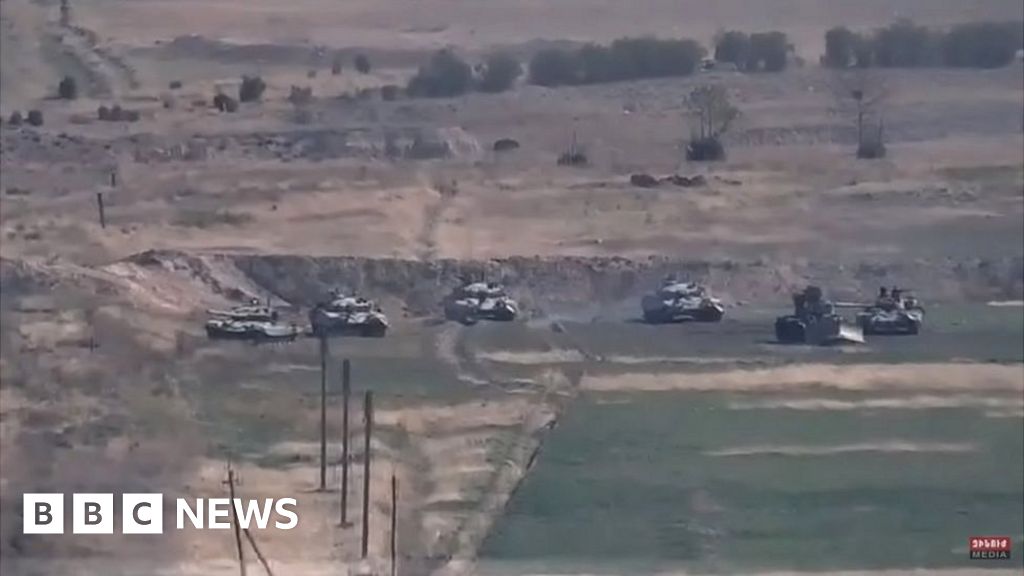One of the world’s oldest conflicts, a territorial dispute between Armenia and Azerbaijan, has re-erupted with the heaviest clashes in years.
At least 23 people were reported to have been killed on Sunday as the two ex-Soviet republics battled over the Nagorno-Karabakh region.
The region is internationally recognised as part of Azerbaijan but controlled by ethnic Armenians.
When it broke away in the early 1990s, tens of thousands died in fighting.
Azerbaijani President Ilham Aliyev said on Sunday he was confident of regaining control over the region.
Martial law has been declared amid the violence in some parts of Azerbaijan, as well as in Armenia and Nagorno-Karabakh.
image copyrightReuters
The conflict in the Caucasus Mountains has remained unresolved for more than three decades, with periodic bouts of fighting.
Any upsurge in violence could unsettle markets as the South Caucasus is a corridor for pipelines carrying oil and natural gas from the Caspian Sea to world markets.
Turkish President Recep Tayyip Erdogan pledged support for Azerbaijan, urging the world to stand with the country in its “battle against invasion and cruelty”. Azerbaijanis are a predominantly Turkic people with whom Turkey has close ties.
Russia, traditionally seen as an ally of Armenia, called for an immediate ceasefire and talks to stabilise the situation.
- UN Secretary-General Antonio Guterres said he was “extremely concerned” over and called for both sides to stop fighting
- France, which has a large Armenian community, called for an immediate ceasefire and dialogue
- Iran, which borders both Azerbaijan and Armenia, offered to broker peace talks
- President Donald Trump said the US was seeking to stop the violence
Emboldened by Turkish support?
By Rayhan Demytrie, BBC Caucasus correspondent
Sunday’s fighting with the use of heavy weaponry along the line of control is the most serious escalation in recent years.
It is common in this decades-long conflict for both sides to accuse the other of firing the first shots and what we are seeing is not just military action but also an information war. It is difficult to independently verify official information.
Azerbaijan’s claim to have “liberated” territory controlled by Armenians has been denied by the Armenian authorities. Similarly, Armenia’s claims to have inflicted heavy losses on Azerbaijani forces have been dismissed by Baku. Moreover, the Azerbaijani authorities have restricted internet use inside the country, in particular access to social media.
Turkey’s emphatic support may embolden Azerbaijan. Back in August, the Azerbaijani defence minister said that with the help of the Turkish military Azerbaijan would fulfil its “sacred duty” – in other words, take back its lost territories.
How did the fighting spread?
Armenia’s defence ministry said an attack on civilian settlements in Nagorno-Karabakh, including the regional capital Stepanakert, began on Sunday morning.
The separatist authorities in Nagorno-Karabakh said 18 people were killed – 16 of their troops, a woman and a child – and 100 wounded.
Azerbaijan said five members of the same family were killed by Armenian shelling.
Martial law is an emergency measure under which the military takes over the authority and functions of the civilian government.
“Get ready to defend our sacred homeland,” Armenian Prime Minister Nikol Pashinyan said after accusing Azerbaijan of “planned aggression”.
Warning that the region was on the brink of a “large-scale war”, he urged the international community to unite to prevent any further destabilisation.

Armenia said it had shot down two helicopters and three drones, and destroyed three tanks during Sunday’s clashes.
Azerbaijan’s defence ministry confirmed the loss of one helicopter but said the crew had survived, and reported that 12 Armenian air defence systems had been destroyed. It denied other losses reported by Armenia.
President Aliyev said he had ordered a large-scale counter-offensive operation in response to Armenian army attacks.
“I am confident that our successful counter-offensive operation will put an end to the occupation, to the injustice, to the 30-year-long occupation,” he said.
After initial denials by the Armenian military, Nagorno-Karabakh’s unrecognised president, Arayik Harutyunyan, confirmed some positions had been lost to Azerbaijani forces.
Nagorno-Karabakh – key facts
- A mountainous region of about 4,400 sq km (1,700 sq miles)
- Traditionally inhabited by Christian Armenians and Muslim Turks
- In Soviet times, it became an autonomous region within the republic of Azerbaijan
- Internationally recognised as part of Azerbaijan, but majority of population is ethnic Armenian
- An estimated one million people displaced by 1990s war, and about 30,000 killed
- Separatist forces captured some extra territory around the enclave in Azerbaijan in the 1990s war
- Stalemate has largely prevailed since a 1994 ceasefire
- Russia has traditionally been seen as an ally of the Armenians






